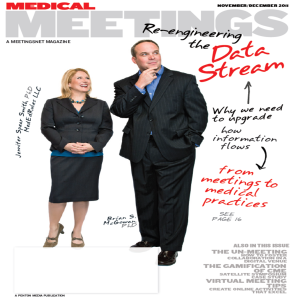CLASSIC POST: Re-engineering the Data Stream from Meetings to Medical Practices
Here is a brief excerpt from our latest Medical Meetings cover story:

For some in the medical community, the frustrations and the inadequacies of the CME system described above are glaring, and many have begun to engineer their own personal workarounds. But homegrown efforts and small peripheral technology solutions aren’t going to fix the inefficiencies and failures of the current knowledge stream.
While “need” and “education” are defined locally, an efficient flow of new medical information into practice requires a re-engineering of the very system of data collection, review, publishing, and subsequent dissemination and education. This means the central players in the medical community—the societies, associations, research institutions, and educational providers—must evolve as well, embracing the parallel movements of rapid-learning healthcare systems and social learning.
This is what is needed to make that happen:
- Data that are presented at annual meetings must be curated more effectively.
- Societies/associations must develop clearinghouse models that enable rapid and open access to new medical information. The education community must avoid wasteful redundancy and develop solutions that instead accelerate knowledge flow.
- Investigators/authors should be obligated to shepherd their new data for a period of time to ensure that questions are answered, limitations discussed, and follow-up research questions can be proposed. These discussions must be public, so learners can put the information in context and make it relevant to their local setting. This means that social learning models and the emergence of new social technologies will likely have a huge impact on how this “aqueduct” system evolves.
- Technology should be woven into the model such that community educational providers can pull the new medical information into their networks. These tools must be engineered to overcome knowledge silos—the community providers cultivate their own crops and take ownership of the local needs for information.
- Local educational providers and learners must stream their feedback into the clearinghouse system so it can assess how the new medical information was received and ensure that best practices in knowledge transfer are being shared.
Every system is designed to achieve the results that it yields. To get different results, the system must be changed.
Some may object to the re-engineering. Some may contest the change in the status quo. But this cannot be about business interests, copyright, or membership value propositions—three challenges that are valid, but can be practically and intelligently addressed though parallel innovation. This re-engineering is first and foremost about improving the flow of medical information
To read the full story see here: Re-engineering the Data Stream from Meetings to Medical Practices.
